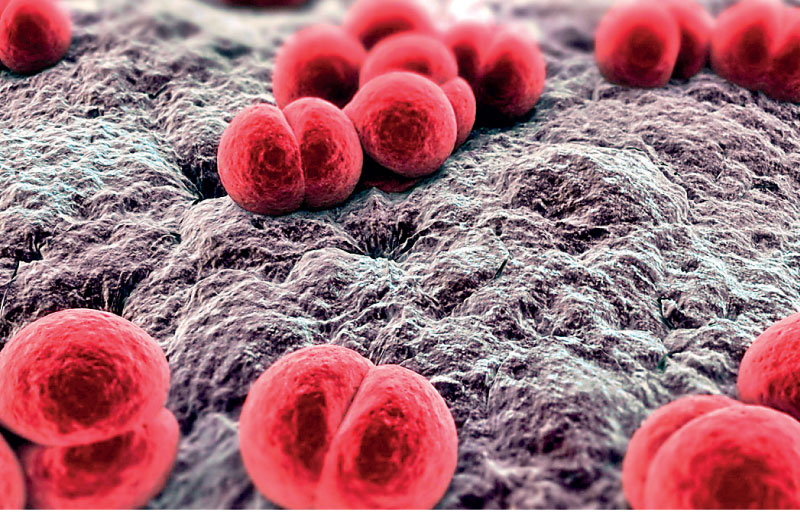Tuesday Dec 09, 2025
Tuesday Dec 09, 2025
Thursday, 14 September 2023 01:43 - - {{hitsCtrl.values.hits}}

Meningococcal disease is caused by the bacterium known as Neisseria meningitidis
|
Dr. Lilani Karunanayake
|
By Randima Attygalle
With the recent detection of an inmate in the Galle Prison with meningococcal disease, there is apprehension caused among the public over potential community spread. However, health authorities reassure that the variant of the disease which is locally detected, is not highly contagious and the public need not panic. “This is also not the first time that meningococcal disease has been reported locally. Although the disease is not commonly reported here at home, every year we detect a few cases of it in several provinces,” Medical Research Institute (MRI) Clinical Microbiology and Molecular Biology Laboratory Head Dr. Lilani Karunanayake told the Daily FT.
The Consultant Clinical Microbiologist further noted that 11 cases were confirmed in 2019/2020 and in the last two years less than five cases were confirmed. “Majority of those belonged to serogroup B and a few serogroup C, neither of which are associated with large epidemics,” she said further.
High risk groups
Meningococcal disease (MD) is caused by a bacterium known as Neisseria meningitidis. The disease occurs worldwide. The incidence rate is similar across the Asia-Pacific region, between 0.02-0.2 per 100,000 persons per year in some countries with higher reported incidence in certain countries or sub-populations. “Although the disease could occur at any age, the burden of MD is higher among children and adolescents throughout the Asia-Pacific region,” explained Dr. Karunanayake. Children and young adults aged 15–24, elderly people over 65 years, household contacts of a person known to have had this disease, immunocompromised people, and people traveling to parts of the world where meningococcal disease is prevalent are also at increased risk of contracting the disease. “Although MD is not as contagious as some viruses, case fatality rate is high in some countries,” noted the Consultant Microbiologist.
Symptoms
The meningococcus germ is spread by direct, close contact with nasal or oral secretions or saliva of an infected person. A person with meningococcal disease may transmit the disease even several days before becoming ill, until the bacteria are no longer present in discharges from the nose and throat. The bacteria do not survive well in the environment outside the human body, so close contact is necessary for disease transmission.
Signs and symptoms of the disease include high fever, headache, skin rash, vomiting and fatigue. Some patients may also experience confusion and sensitivity to light. “In some patients the disease can give rise to an acute illness that progresses rapidly to what is known as ‘sepsis’, and can lead to death, while in others it may develop to acute meningitis,” said Dr. Karunanayake, who went on to say that clinical diagnosis of MD is difficult due to similar clinical features with other diseases.
Laboratory diagnosis
Laboratory diagnosis involves ‘cultures’ of samples of blood or cerebrospinal fluid (fluid near the spinal cord) from which the bacteria are ‘grown’ in the laboratory. “Isolation of the organism is important, to observe the effectiveness of antibiotics in the local context. This will help clinicians to select appropriate antibiotics. A PCR test is used for confirmation of the disease. This test could confirm MG even in the absence of bacterial growth by testing the patient’s blood,” the Microbiologist pointed out. She also said that only these two methods (culture and PCR) can confirm the diagnosis with definite certainty.
Close contacts of someone with MD should also receive antibiotics, to help prevent them from getting the disease.
Global travel
Spread of meningococcal infection could occur due to increased global travel. As a preventive measure, a tetravalent vaccine (this is a vaccine that protects against four strains of the bacterium) is mandatory for people who travel to endemic areas and Hajj pilgrims and Ramadan Umrah pilgrims in Saudi Arabia. In addition, the vaccine is recommended for Sri Lankan students travelling to USA, UK and Australia especially if they plan to live in residence halls. The vaccine is available from the Port Health Office located at the MRI, Colombo 8.
The Clinical Microbiology and Molecular Biology Laboratory at the Department of Bacteriology, Medical Research Institute is the WHO ‘Surveillance Focal Point’ for Neisseria meningitidis (the bacterium causing meningococcal disease). The recent case studies on MD here at home, as Dr. Karunanayake pointed out, reveal that most patients have been in urban, crowded areas. Recent studies have concluded that although invasive meningococcal infection is reported as sporadic cases in the country, they are epidemiologically-linked, suggesting internal transmission in places of overcrowding.
“Awareness about this emerging disease is limited at the moment in Sri Lanka. Therefore we need to carry out public education, appropriate selection of diagnostic facilities and effective therapy which are available in the country. Establishing laboratory facilities for serogrouping of Neisseria meningitidis for surveillance is currently a priority in the National Reference Laboratory of the MRI,” she concluded.